Finance Accounting INTRODUCTION 4 BUSINESS RPORT
25 Pages7261 Words384 Views
Added on 2020-10-05
About This Document
Conventions and concepts relating to consistency and material disclosure 6 CLIENT 1 7 (a) Journal Entry in the books of David: 7 (b) Ledger Accounts:9 (c) Trial Balance as at 31st January, 2018: 14 CLIENT 2 16 (a) Statement of profit and loss for Peter Hampau for the year ended 31st July 201816 (b) Statement of financial position for Peter Hampau as at ended 31st July 2018 17 CLIENT 3 18 (
Finance Accounting INTRODUCTION 4 BUSINESS RPORT
Added on 2020-10-05
ShareRelated Documents
Finance accounting
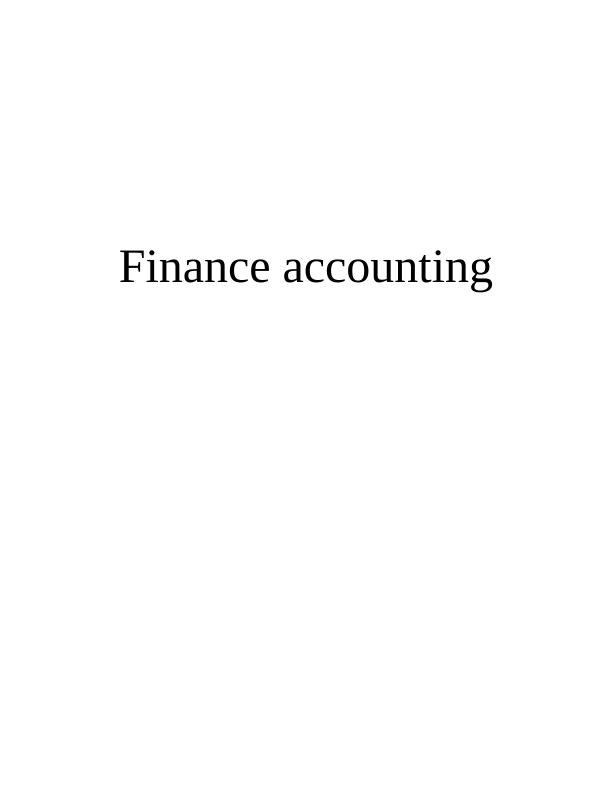
Table of ContentsINTRODUCTION...........................................................................................................................4BUSINESS REPORT......................................................................................................................41. Define financial accounting and its purpose ...........................................................................42. Regulations relating to financial accounting:..........................................................................53. Describe accounting rules and principles................................................................................54. Conventions and concepts relating to consistency and material disclosure............................6CLIENT 1........................................................................................................................................7(a) Journal Entry in the books of David:......................................................................................7(b) Ledger Accounts:...................................................................................................................9(c) Trial Balance as at 31st January, 2018:................................................................................14CLIENT 2......................................................................................................................................16(a) Statement of profit and loss for Peter Hampau for the year ended 31st July 2018 .............16(b) Statement of financial position for Peter Hampau as at ended 31st July 2018 ...................17CLIENT 3......................................................................................................................................18(a) Profit and loss account of Bowling Limited:........................................................................18(b) Balance Sheet of Bowling Limited......................................................................................18(c) Accounts concepts : Consistency and Prudence:..................................................................19(d) Purpose of depreciation in formulating accounting statements and methods ofDepreciation:..............................................................................................................................19CLIENT 4......................................................................................................................................20(i) Bank reconciliation statement at 1st December 2017:..........................................................20(ii) Durrell Ltd's updated cash book for December 2017 :........................................................20(iii) Bank Reconciliation Statement as at 31"t December 2017:...............................................21CLIENT 5......................................................................................................................................21(a) Sales Ledger Control and Purchase Ledger Control Account:.............................................21(b) Control Account:..................................................................................................................22CLIENT 6......................................................................................................................................22(a) Suspense Account:................................................................................................................22(b) Preparation of Trail Balance:...............................................................................................23
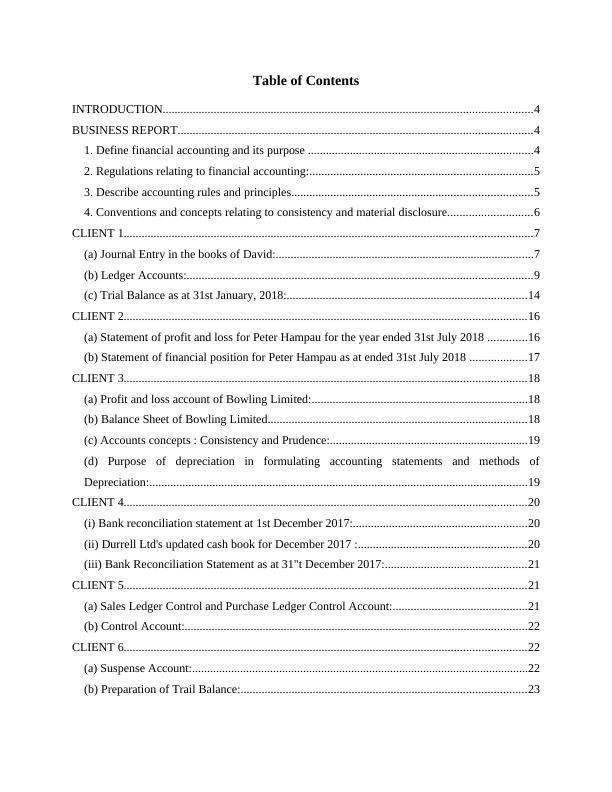
(c) Journal entries in order to show necessary corrections for eliminating suspense accountbalance:......................................................................................................................................23(d) Difference between a Suspense A/c and Clearing A/c:........................................................24CONCLUSIONS............................................................................................................................24REFERENCES .............................................................................................................................25
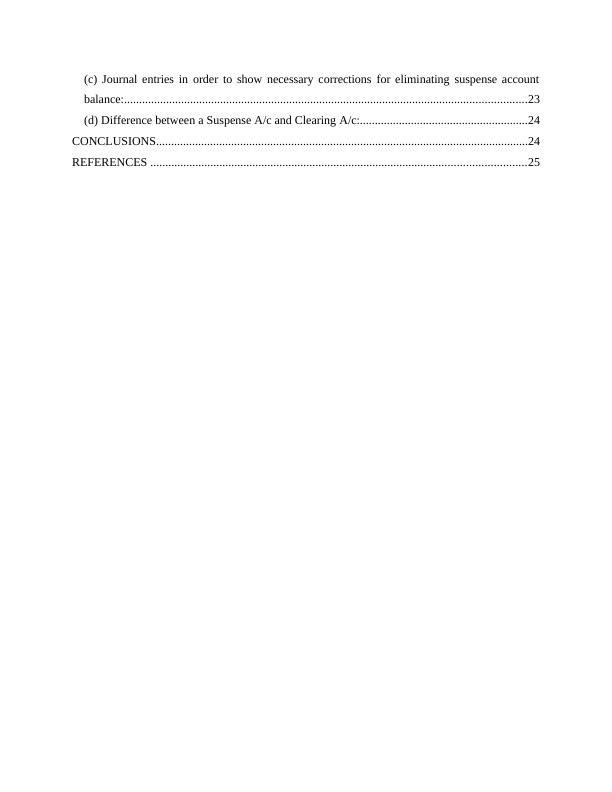
INTRODUCTIONFinancial Accounting is an area of accounting that considers cash or other monetaryitems as a basis of determination of performance rather than as a determinant of production. Infinancial accounting process accounting data or information is classified as cash inflow and outoutflow in terms of revenue and expenditure, assets and liabilities. Financial data andinformation are collected and then summarised in order to prepare financial statements, incomestatements, cash flows, change in equity for reporting purpose (Edwards, 2013). In financialaccounting main motive of organisation is to present financial data and information in asystematic manner for user of financial data such as investors, relevant authorities, lenders andcreditors, debtors etc. This report describes purpose of financial accounting, regulationsconcerned with financial accounting, rules and principles of accounting, different aspects offinancial reporting including concepts and conventions related to consistency and materialdisclosure. BUSINESS REPORT1. Define financial accounting and its purpose Financial accounting: It refers to set of activities related to preparation of financial statementsto present or report financial performance and position to internal or external users of financialdata. Major activities of financial reporting includes recording, classifying, summarising,posting, analysing and reporting of financial data or information of business organisationincluding drafting of financial statements such as balance sheet, profit and loss and cash flowanalysis. Financial accounting not only covers monetary items but also non monetary itemswhich assists in reporting purpose. Financial accounting starts with collection of financial dataand information and ends with reporting of financial performance and position (Fourie, 2015). Infinancial accounting process accounts are prepared in accordance with local and internationalaccounting assumption and standards. Purpose of financial accounting: The primary purpose of financial accounting is reporting offinal accounts to external or internal. Financial accounting assists in compliance of rules andregulations prescribed by relevant authorities. Financial accounting through internal checkensures accuracy in recording of financial information and data. It assists in identification ofsuitable accounting policies, assumptions, conventions and other fundamentals as per business
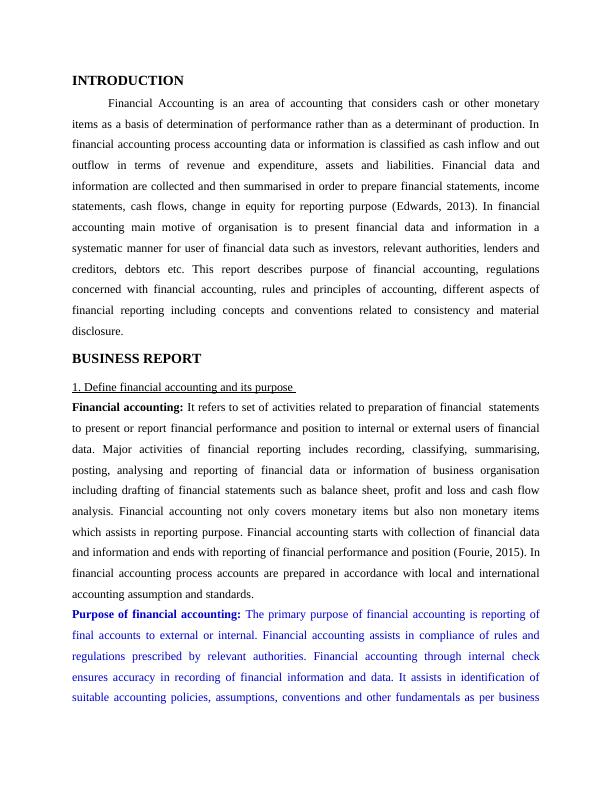
structure of organisation. Financial accounting provides a basis for choosing and implementing amost appropriate strategy as per business requirement. Actual outcomes regarding financialperformance and position of business organisation under financial accounting process define theobjectives and goals of company.2. Regulations relating to financial accounting:Regulations refers steps normally in form of order, taken by relevant authority orgoverning body to control and regulate activities of organisations or individuals. To establishproper control and to maintain uniformity in accounts relevant authorities create regulations.Regulations relating to financial accounting: Regulations provides guidance for preparation andpresentation of financial accounts such as generally accepted accounting policies and standards.Some regulations are applicable for business organisations operating its business globally such asIFRS (International financial reporting framework). For making uniformity in financialaccounting process some regulations are framed regarding accounting assumptions, concepts,methods, conventions and policies (Hale and Held, 2012). For business organisation regulatedunder any specific act, regulations are framed under such relevant act.3. Describe accounting rules and principlesData and information are initially recorded using accounting entries. There are someaccounting rules are discussed below which helps the organisation to smooth their financialaccounting process:Debit what comes in, credit what goes out: This rule is mainly framed for real account.Real accounts includes all assets of a firm whether tangible or intangible such as plant andmachinery account, furniture and fixture, goodwill, land and buildings account, free holdpremises etc. Real accounts are classified as Tangible real accounts and Intangible real accounts.Tangible real accounts includes building accounts, plant account, inventory account etc. WhereasIntangible real accounts includes accounts of items which do not have any physical existencesuch as goodwill, patent, copyright etc. Debit the receiver, credit the giver: This rule is framed for personal accounts. Personalaccount refers to a general ledger account concerned with individuals, firms and associations likecreditors account, debtors account, capital account, banks account etc. Under this rule if persongive something to organisation it treated as inflow therefore personal account will be credited
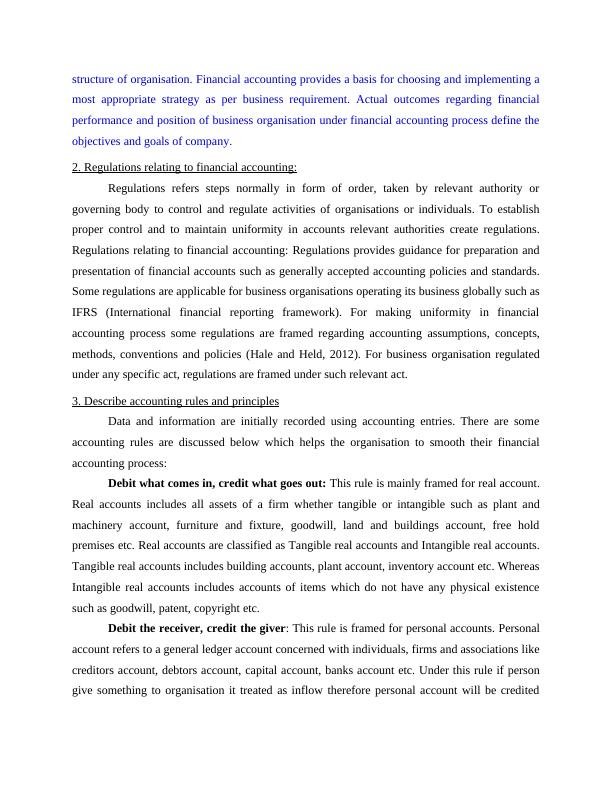
and if person receive something from the organisation than amount should be debited on name ofperson (Hall, 2012).Debit all expenses and losses, credit all incomes and gains: This rules is framed fornominal account. Nominal account refers to General ledger account concerned with all revenuesor income, expenses, losses and gains. In this rule capital is treated as liability for business andliability shows credit balances. Incomes and gains leads to increase in capital therefore allincomes and gains are credited whereas all expenses and losses should be debited becauseexpenses or losses leads to decrease in capital.Principles: Following are the major principles of accounting that provides a framework for preparation of final accounts, are as follows:1.Dual aspect concept: Dual aspect concept truly resembles to double entry system.According to dual aspect concept each and every transaction in an business organisationaffects both debit and credit side simultaneously. Under Single entry system only oneside of an account is affected which creates complexity in accounting calculationtherefore single entry system is avoided by entities (Jönsson, 2013).2.Cost principle: This principle emphasises on reporting of assets on their cost. As perthis principle business organisation should record their assets on actual cost.3.Matching principle: According to this principle, all expenses of business should bematched with revenues which are occurred or being occurred in particular period. 4. Conventions and concepts relating to consistency and material disclosureAccounting convention refers to guideline and framework for adoption of accountingprinciples. It includes general practices and guidelines which assists in preparation of finalaccounts (Mullinova, 2016). Accounting conventions are used in areas where no accountingstandard is prescribed. Conventions are applied by business organisations as per theirrequirements to reduce complexity in accounting process. Convention of consistency: Conventions of consistency emphasises on maintainingconsistency in applied policies and assumptions from period to period. Use of thisconvention assists in preparation of comparative accounts and to reduce complexities inaccounting process.
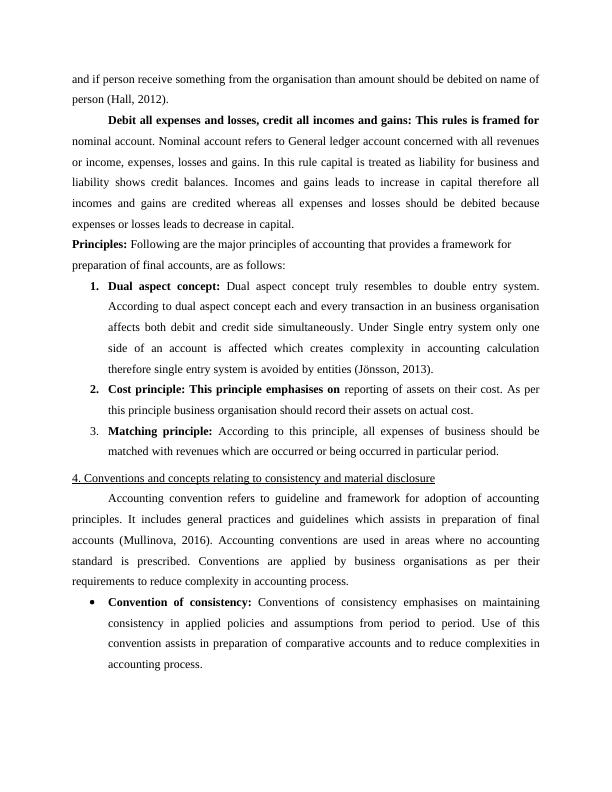
End of preview
Want to access all the pages? Upload your documents or become a member.
Related Documents
Introduction to Financial Accountinglg...
|30
|5105
|401
Financial Accounting Assignment - Zync Solutionslg...
|29
|5360
|97
Financial Accounting Principles Assignment - RBS Accountants Ltdlg...
|26
|7021
|485
Financial Accounting Principles Assignment - Doclg...
|30
|7212
|286
1.Financial Accounting and its Purposeslg...
|27
|6999
|247
Financial Accounting Principles INTRODUCTIONlg...
|27
|6810
|416
